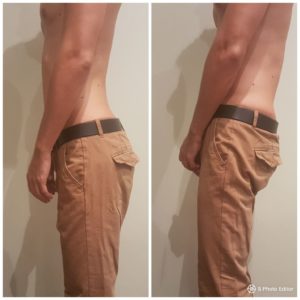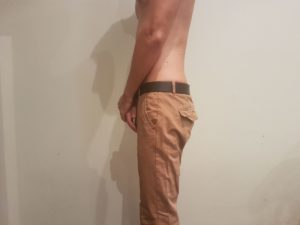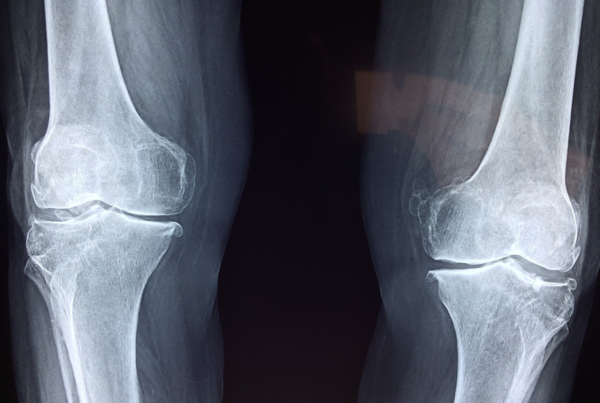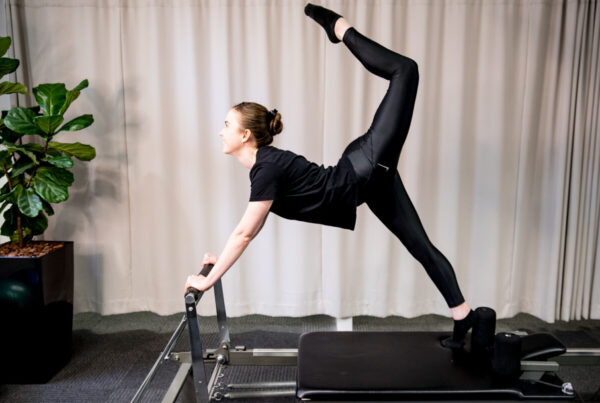Squatting is one of the best whole body functional movements that works virtually every muscle. You know this because gym junkies, “instagram guru’s”, exercise physiologists, personal trainers and physiotherapists alike have been singing the benefits of this all encompassing compound movement for years. If you’re reading this blog we don’t need to sell it to you. What we do want to ensure is that you’re squatting correctly and not putting your body, and in particular, your lumbar spine and knees in jeopardy.
I’m a big fan of group exercise classes but as a Physio I’m not a fan of trainers who push people into squatting repeatedly before they have developed the correct squat technique and foundations. Lets look at two of the most common problems I see on a regular basis.
1) Poor lower back and pelvic control during the squat.
This may sound easy but in reality people don’t seem to have the body awareness or know how of what this actually means. Have a look at this picture of a patient standing up and lets look a little more closely at the relationship between the lower spine and the pelvis.
On the left hand side you will see the patient that has a large scoop in his lower back and his belt line is tilting downwards towards the ground. This is an example of having the pelvis an anterior tilt. This is not ideal
Now if you look at the right hand side of the picture the patient has now completely lost all of the scoop in his lower back and his belt line is actually pointing upwards towards the sky. This is also not ideal
Now lets look at the next picture for the correct lumbo-pelvic alignment.
See how in this picture there is a natural looking scoop in the lower back and his belt line is completely horizontal – no longer tilting upwards or downwards. This is the ideal position to maintain when completing your squat. This is what we refer to as a “neutral” lumbar spine and is what we want you to maintain during the entire squat. This is easier said then done.
One common mistake people may not realise they are doing is starting the squat with the correct alignment and then losing their form at a certain depth in the squat. Take a look at this video and see if you can see what’s wrong with it.
Are you able to see the rounding of the back when they squat past a certain depth, which is also called a “butt wink” here in physioland. This may seem like a small negligible movement however if you’re rounding your back every time squat at the gym repeatedly and then adding weights on top it does put undue stress on your spinal discs.
If you find yourself doing a “butt wink” or are having trouble knowing how far you should squat have a look at this YouTube Video by one of the founding fathers of spinal health Stuart Magill.
There could be a variety of factors that contribute to poor pelvic control during a squat including, poor ankle mobility, tight hip flexors, stiffness through the lumbar spine just to name a few. Here at Bend and mend our fully qualified physiotherapists will be able to find out the underlying cause and offer solutions through manual therapy and exercise to maintain correct position through your entire squat.
2) Knees “cave in” towards the midline
The second most common mistake we see is people bringing their knees in towards the midline. Take a look at this video and notice that both of the patient’s knees shift in towards the midline.
This puts unnecessary extra pressure on the knee joint capsule and ligaments. Again this can potentially lead to injury when done repeatedly and adding large weights. Often this issue can be addressed by simply giving patients feedback and cues other times it may well be something a little more complicated like a problem with patient’s strength and motor control in their glute musculature. If you find yourself struggling with this here at bend and mend we can quickly find the underlying cause and get you on an exercise program to address this issue.
As you can see there’s more to the squat than just sitting down and getting back up again. This is by no means a comprehensive list of mistakes people make at the gym while squatting but it covers two common mistakes I see on a daily basis. If you’re not squatting right not only are you not working the correct muscles you can potentially cause an injury or do your body long term harm. If you are experiencing any pain, losing your form or simply just want to work on your squat game, come in to Bend + Mend in Sydney’s CBD to see one of our qualified Physiotherapists.









